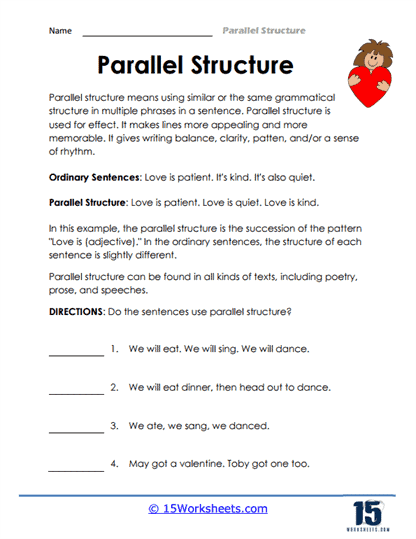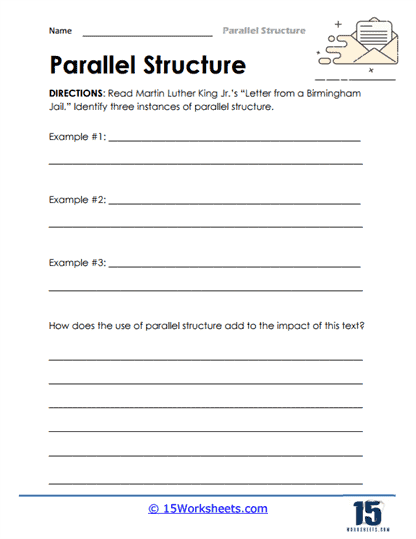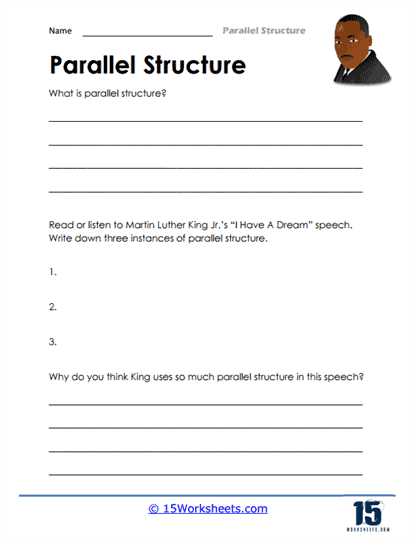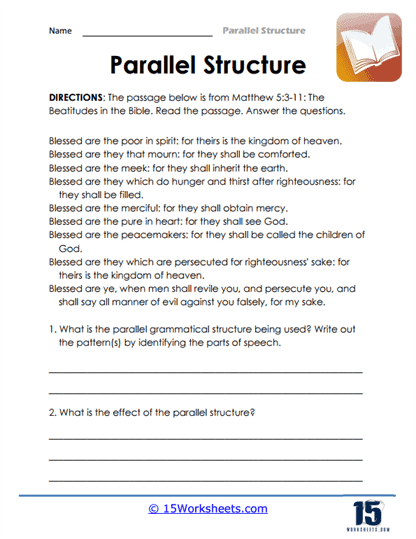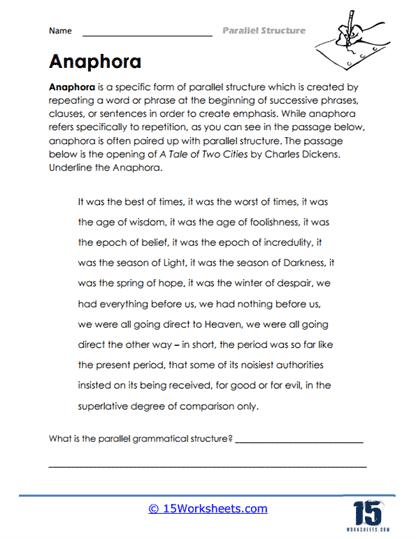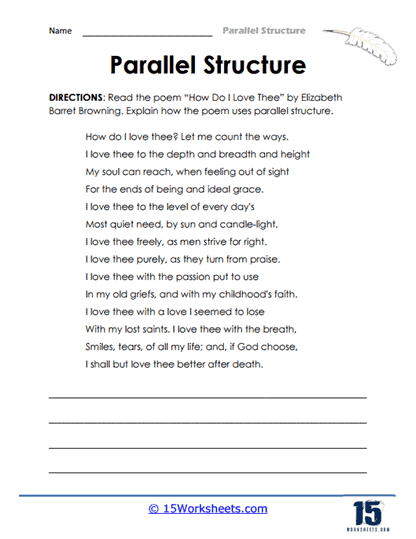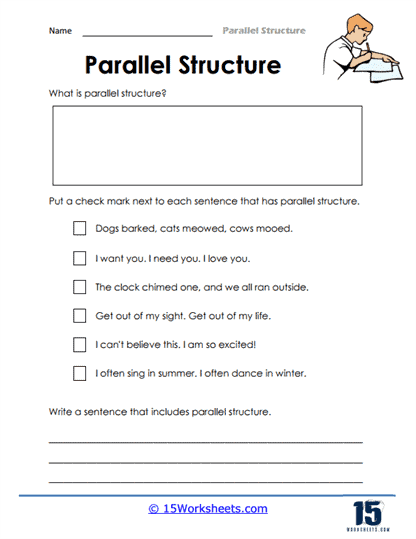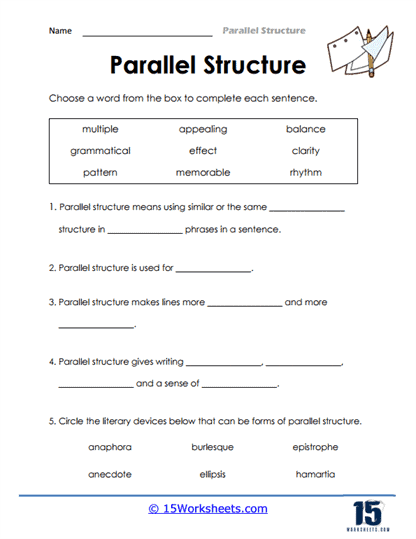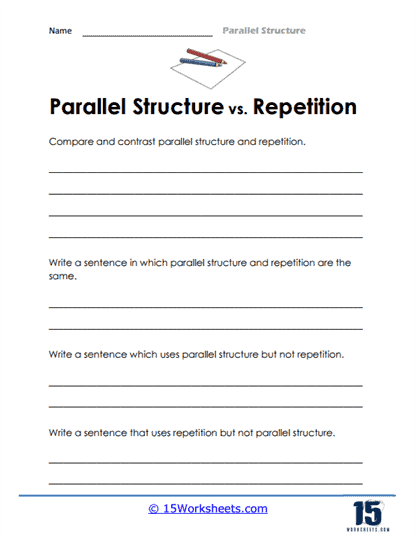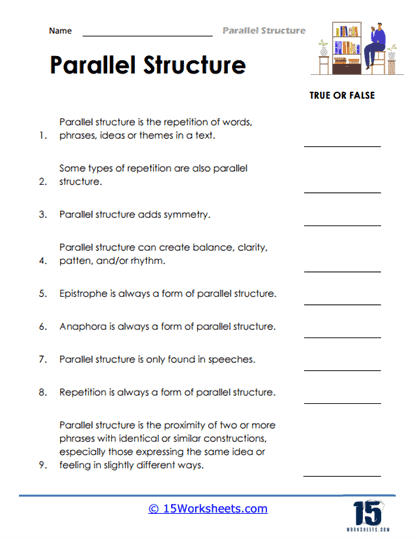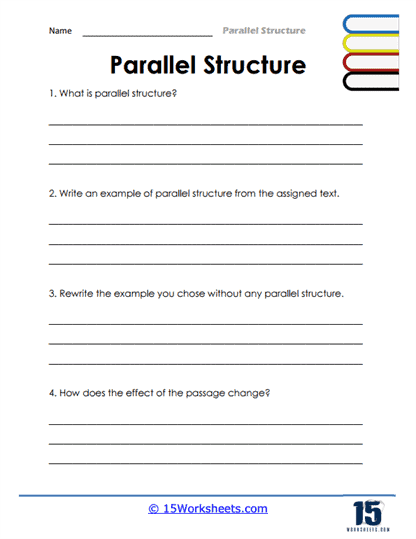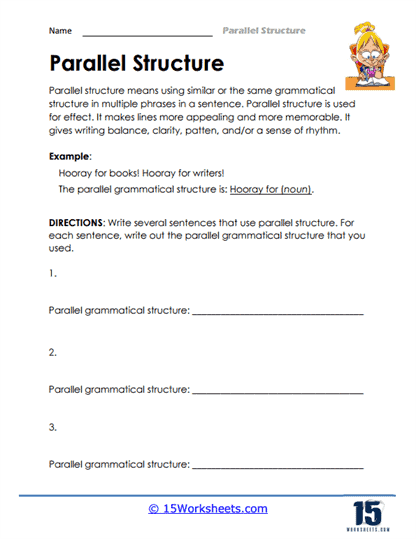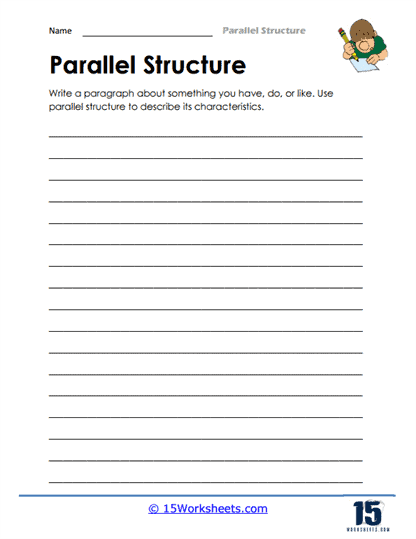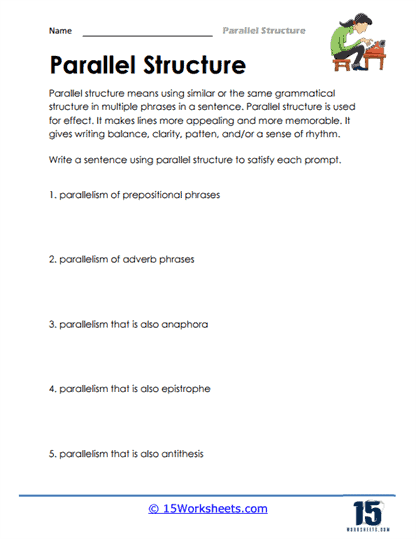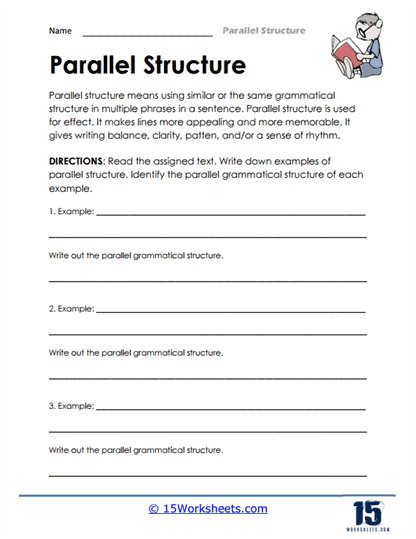Parallel Structure Worksheets
About These 15 Worksheets
Parallel structure, also known as parallelism, is a crucial element in English grammar and writing, referring to the use of consistent patterns of words to show that two or more ideas have the same level of importance. Parallel structure worksheets are educational tools designed to help students understand and practice this concept. These worksheets provide a variety of exercises aimed at enhancing a student’s ability to use parallel structures effectively in writing and speech. Let’s explore the concept of parallel structure, the types of exercises found on these worksheets, and how they benefit students’ grammar and writing.
The varied exercises on these worksheets cater to different learning styles, helping students reinforce their understanding of this crucial grammatical concept. By incorporating these exercises into their study routines, students can significantly enhance their grammar, writing style, clarity, and overall effectiveness in communication. Mastery of parallel structure is not just a key academic skill but also a vital component of eloquent and persuasive writing and speaking.
Types of Exercises
Identification Exercises – Students identify sentences with correct and incorrect parallel structure. This helps them recognize what constitutes parallelism.
Error Correction Tasks – These exercises present sentences with parallelism errors, and students are asked to rewrite them correctly, improving their editing skills.
Matching Exercises – Here, students match sentence halves to form sentences with parallel structure. This aids in understanding how to construct balanced sentences.
Rewriting Sentences – Students take non-parallel sentences and rewrite them with proper parallel structure. This task reinforces their understanding and ability to apply parallel structure.
Fill-in-the-Blanks – These exercises provide sentences with missing words or phrases that the student must fill in, focusing on maintaining parallelism.
Multiple Choice Questions – Students choose the option that correctly completes a sentence with parallel structure, enhancing their ability to identify correct parallelism.
Writing Prompts – Students are asked to write paragraphs or short essays using parallel structure, applying the concept in longer pieces of writing.
Creating Lists or Series – Exercises where students have to create lists or series within sentences, ensuring each item is in parallel form.
Comparing and Contrasting – Students analyze pairs of sentences to identify which one uses parallel structure and why it’s more effective.
Sentence Combining – Students combine multiple short sentences into one longer sentence using parallel structure, practicing how to express complex ideas succinctly.
What is Parallel Structure in a Sentence?
Using the same pattern of words to indicate that two or more words or concepts are equally important is known as parallel structure, also known as parallelism. A sentence’s words and phrases should be similar not just in form but also in tense. Writers utilize parallel structure to improve their writing’s clarity, make it simpler to read, and demonstrate that it is grammatically and structurally sound. Students can start by examining examples of parallel structures to better comprehend the idea.
Through these worksheets, students will be able to:
- Identify when sentences properly use parallel structure;
- Define parallel structure in their own words and understand its function and importance;
- Learn the various forms of parallel structure and identify them in passages;
- Complete sentences or create their own while using parallel structure;
- Compare parallel structure and repetition;
- And understand various parallel grammatical structures.
In these worksheets, students will learn to recognize the importance of parallelism in creating effective communication and how it can improve clarity and coherence in their writing. Through various exercises, they will develop the skills to identify and correct errors in parallel structure, ultimately leading to a more polished and professional style of writing.
Why is Parallelism Important?
Similar grammatical constructions are referred to as parallelism in sentences. Grammarly comparable, or grammatically matched, elements should be used to represent elements in sentences that have the same purpose or convey similar thoughts. In literature, speeches, ads, and popular music, parallelism is a rhetorical and stylistic strategy. Writing gains harmony and beauty via parallelism. It can help a statement stick in the mind. Parallelism is crucial, even in prose not intended for grandeur.
Faulty parallelism is the failure to construct linguistically parallel structures when they are necessary. Note the distinction between proper parallel construction and flawed parallelism in the examples that follow. Check your own writing for errors in parallelism. Parallelism is required between nouns, participles, gerunds, infinitives, and clauses. Nouns should be used with other nouns wherever possible.
Sentences with parallel structures flow more smoothly. It maintains the equilibrium of your text and makes it simpler to read. It also demonstrates the equal value of all thoughts. Your text may seem weird to readers if there are parallel structural errors. You will be asked to spot parallel construction mistakes on several examinations, including the SAT, in order to demonstrate your writing skills. Review these instances of parallelism in literature and rhetoric to deepen your understanding of parallel structure in writing.
Examples
A parallel structure is when two or more concepts are given equal weight by employing the same word patterns. At the word, phrase, or sentence level, this can take place. Coordinating conjunctions like “and” or “or” are typically used to connect parallel structures.
Not Parallel;
He was a bad student, according to the teacher, because he didn’t study for the test until the very last minute, carelessly performed his lab exercises, and lacked ambition.
Parallel;
He was a bad student, according to the teacher, because he didn’t study for the test until the very last minute, carelessly performed his lab exercises, and lacked ambition.
Pay attention to how a list of things or a group of objects sound. Do you detect the same sounds? For instance, does each item start with a string of “-ing” words? Or do you detect a recurring rhythm? See whether something needs to be paralleled if it is interfering with the rhythm or sound recurrence. At the phrases ‘or’ or ‘and’ pause while you scan your page. Verify that the objects linked are parallel on both sides of these words. Alternatively, make them parallel. To determine if two or more items in a list are parallel, arrange them in a column.
The term “parallel structure” refers to the repetition of a certain grammatical form while using the same word pattern. Multiple concepts or pieces of information are emphasized to have equal value in the same phrase.
If a sentence has two or more numbers of information, the remaining concepts must be expressed using the first number’s grammatical form. Multiple pieces of information are often joined in a parallel structure by coordinating conjunctions. In various sentences, a parallel structure can be created at the word, phrase, or clause level.

